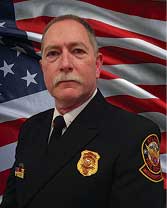Editor’s Opinion | By David Rhodes

If you have attended FDIC International in Indianapolis, maybe you had dinner at Tony’s Steak House or stayed at the Embassy Suites on the corner of Washington Street and North Illinois Street. Way before the fire service masses were gathering each year to participate in the numerous training classes; discussing future product improvements; and seeing the latest innovations from the fire service equipment, tool, and technology manufacturers, there was an Indianapolis resident working on a major project in a building on that very corner—the invention of a device that would save countless lives and revolutionize occupants’ ability to escape burning buildings. His name was Karl Prinzler.
Prinzler was born in 1870 in Indianapolis. At age 17, he took a job as a salesman at the Vonnegut Hardware store on Washington Street (the current location of Tony’s Steak House and the Embassy Suites). At age 27, he became the sales manager for the builders’ hardware department. In December 1903, he was in Chicago on business. After several successful meetings, he was eager to get home. It was Wednesday, the day before New Year’s Eve, and he attempted to get a train ticket back to Indianapolis. No tickets were available, and although he desperately wanted to get back, he was determined to make the best of his extra day in Chicago.
He decided to take in a show at a newly constructed theater touted as better than anything else in the country—even better than the acclaimed theaters in New York City. The show was Mr. Blue Beard and the venue was the Iroquois Theater located at 24-28 West Randolph Street. Prinzler stopped by the train station one more time just to see if any seats had become available. He was in luck! He quickly purchased a ticket and made his way to the train heading back to Indianapolis, forgoing Mr. Blue Beard.
That afternoon in Chicago, the show opened to a record crowd. Standing-room-only tickets were sold, and the venue, with a capacity of 1,200, now had 1,800 patrons inside. The theater had only been open a month, and there were still a few problems that the staff continued to work out and a few things that weren’t quite finished. To prevent people from sneaking in through emergency exits, a new type of lock was installed that required training to unlock. The roof vents directly over the stage, designed to be opened to draw any fire up and away from the audience, were still secured shut and not operational. The person whose job it was to lower the massive fire curtain was out sick, and his backup wasn’t trained in its operation. A perfect storm!
A theater lamp shorted out and set the stage curtain on fire. When the actors realized the problem, one of them calmly told everyone to stay in their seats. Only one fire extinguisher was available, and it was deployed but did not extinguish the fire. A crew member attempted to lower the fire curtain, but it became stuck and only partially deployed. With the vents closed and the fire curtain only partially lowered, the fire quickly spread to the upper levels, enveloping the audience in thick, toxic smoke. All the upper-floor exit doors were locked. The heat and smoke banked down on the lower level. Only one set of doors was opened, allowing patrons to exit through the first floor, because staff members didn’t know how to work the new locks. The fire lasted 16 minutes and, in the end, 602 of the estimated 1,800 were dead.
- Forcible Entry on Exit Hardware
- Training Minutes: Door with Panic Hardware
- Firefighter Training Drill: Forcing Double Doors with Cross Bar Panic Hardware
Prinzler had made it home and learned of the fire the next morning from a report in the Indianapolis Star, the local newspaper. He could have been there. His near brush with fate disturbed him to a point that it provided an obsessive desire to learn everything he could about the tragedy and find a solution to the problems experienced by the fire victims.
He collaborated with his neighbor Henry Dupont, an architect, and Mr. Vonnegut, the owner of the hardware store. They began tackling the problem of a theater door that could be secured and locked from the outside but easily opened with no special tools or training. They came up with a self-releasing fire exit device that would automatically unlock the door and allow it to swing outward and open even if the only thing that happened was pressure being put on the door from the rush of a panicked crowd being forced against it. It took no special training to operate. This bar configuration totally solved a major problem experienced at the Iroquois Theater. Taking portions of the names of each of the three men that designed it, it was known as the Von Duprin device and became the first of what we commonly call panic hardware. It quickly gained acceptance in multiple applications and eventually made its way into fire codes across the nation and, ultimately, the world.
We should all find inspiration in Prinzler’s story and not just accept tragedy or close calls when we experience them. Learning from our experiences and innovating change are an essential part of our responsibility as members of the fire service. You might have just the right experience and motivation to make the next big difference!


